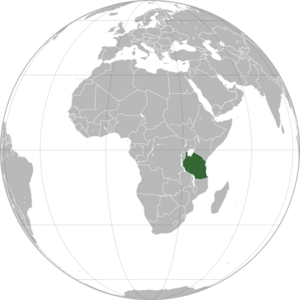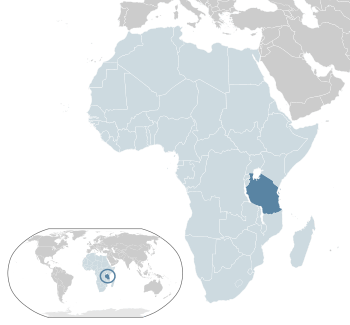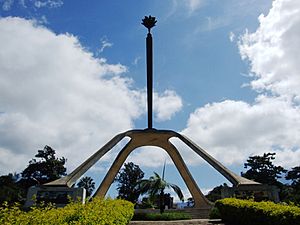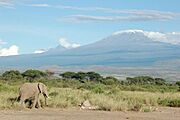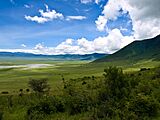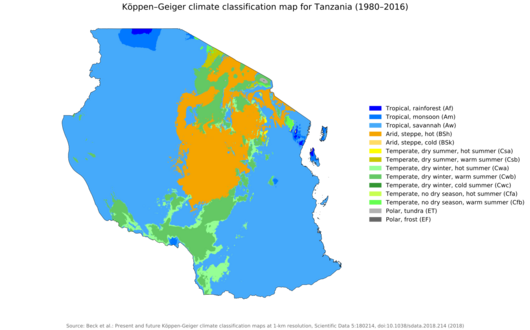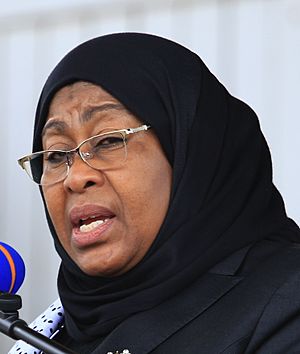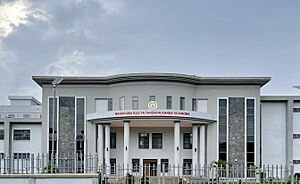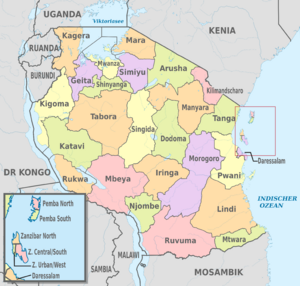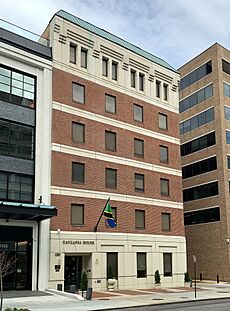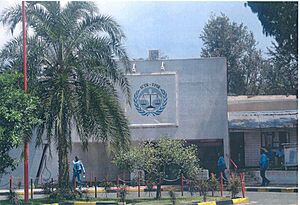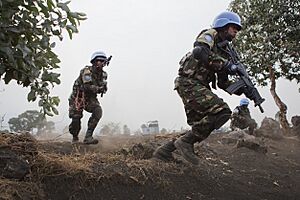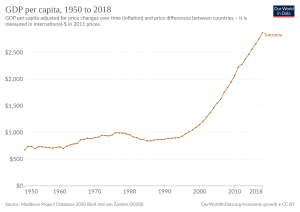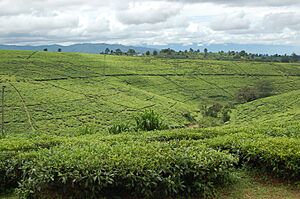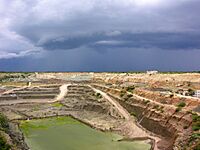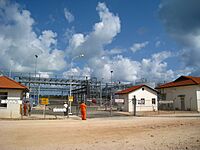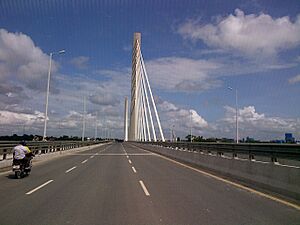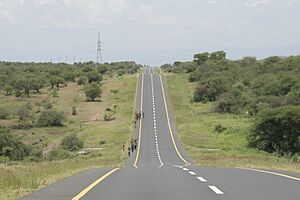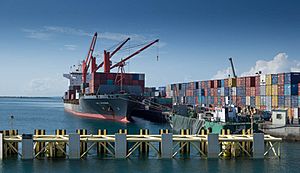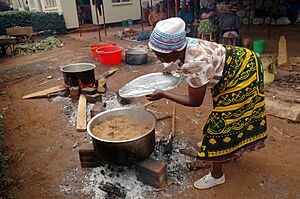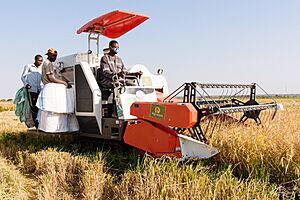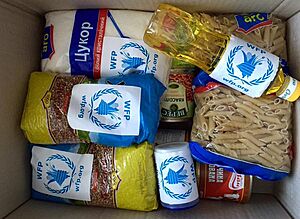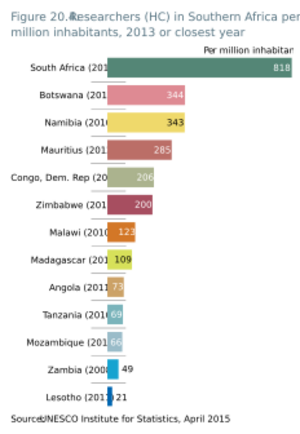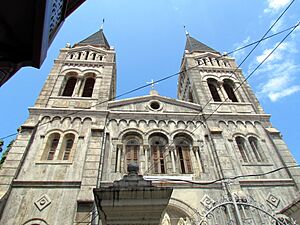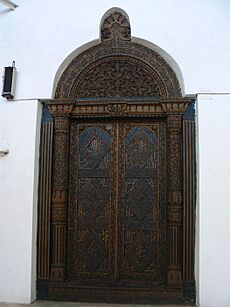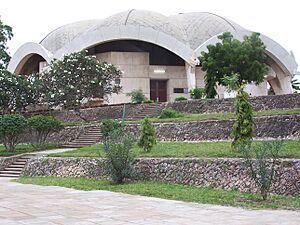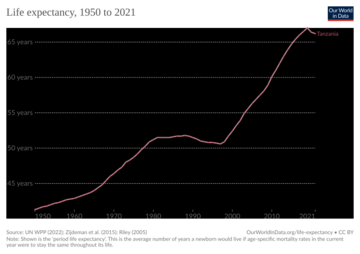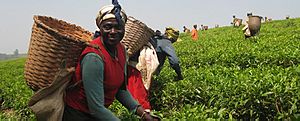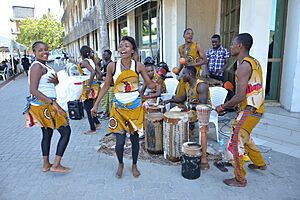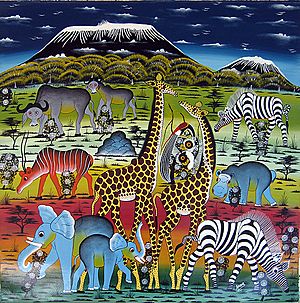Tanzania facts for kids
Quick facts for kids
United Republic of Tanzania
Jamhuri ya Muungano wa Tanzania (Swahili)
|
|
|---|---|
|
|
|
|
Motto: "Uhuru na Umoja"
"Freedom and Unity"
|
|
|
Anthem: "Mungu ibariki Afrika"
"God bless Africa" |
|
| Capital | Dodoma 6°10′S 35°44′E / 6.167°S 35.733°E |
| Largest city | Dar es Salaam 06°48′S 39°16′E / 6.800°S 39.267°E |
| Official languages | |
| National language | Swahili |
| Other languages | Over 100 languages, including (1m+):
|
| Religion
(2020)
|
|
| Demonym(s) | Tanzanian |
| Government | Unitary dominant-party presidential republic |
| Samia Suluhu Hassan | |
|
• Vice-President
|
Emmanuel Nchimbi |
| Mwigulu Nchemba | |
| Legislature | National Assembly |
| Independence from the United Kingdom | |
|
• Tanganyika
|
9 December 1961 |
|
• Zanzibar
|
10 December 1963 |
|
• Unification of Tanganyika and Zanzibar
|
26 April 1964 |
|
• Current constitution
|
25 April 1977 |
| Area | |
|
• Total
|
947,303 km2 (365,756 sq mi) (30th) |
|
• Water (%)
|
6.4 |
| Population | |
|
• 2024 estimate
|
67,462,121 (23rd) |
|
• 2022 census
|
|
|
• Density
|
65.2/km2 (168.9/sq mi) (147th) |
| GDP (PPP) | 2025 estimate |
|
• Total
|
|
|
• Per capita
|
|
| GDP (nominal) | 2025 estimate |
|
• Total
|
|
|
• Per capita
|
|
| Gini (2017) | ▲ 40.5 medium |
| HDI (2023) | medium · 165th |
| Currency | Tanzanian shilling (TZS) |
| Time zone | UTC+3 (East Africa Time) |
| Driving side | left |
| Calling code | +255 |
| ISO 3166 code | TZ |
| Internet TLD | .tz |
Tanzania, officially called the United Republic of Tanzania, is a country in East Africa. It is part of the African Great Lakes region. Tanzania shares borders with Uganda and Kenya to the north. To the east is the Indian Ocean. Mozambique and Malawi are to the south. Zambia, Rwanda, Burundi, and the Democratic Republic of the Congo are to the west. In 2024, Tanzania had about 67.5 million people. This makes it the most populated country located entirely south of the equator.
Many important hominid (early human) fossils have been found in Tanzania. Long ago, different groups of people moved into Tanzania. These included Southern Cushitic speakers from Ethiopia and Eastern Cushitic people from north of Lake Turkana. Also, Southern Nilotes like the Datoog came from the South Sudan–Ethiopia border area. These groups arrived around the same time as the Mashariki Bantu people from West Africa settled near Lake Victoria and Lake Tanganyika.
In the late 1800s, mainland Tanzania became part of German East Africa. After World War I, the British took over and called it Tanganyika. The Zanzibar Archipelago was a separate British colony. Tanganyika became independent in 1961, and Zanzibar in 1963. In 1964, they joined to form the United Republic of Tanzania. Tanzania is still a member of the Commonwealth.
Today, Tanzania is a republic led by a president. Its capital city is Dodoma. However, Dar es Salaam is the largest city, main port, and business center. The Chama Cha Mapinduzi party has been in power for a long time. Tanzania has been peaceful since its independence. It is seen as one of the safest and most stable countries in Africa.
Tanzania has about 120 different ethnic, language, and religious groups. Christianity is the largest religion in Tanzania. There are also many Muslims and followers of traditional beliefs. Over 100 languages are spoken, making it very diverse in language. Swahili is the national language. English is used for trade, diplomacy, and in higher education. Arabic is spoken in Zanzibar.
Tanzania has mountains and thick forests in the northeast. This is where Mount Kilimanjaro is located. It is the highest mountain in Africa. Three of the African Great Lakes are partly in Tanzania. These include Lake Victoria (Africa's largest lake) and Lake Tanganyika (the deepest lake). Lake Malawi is to the south. The eastern coast is hot and humid, with the Zanzibar islands nearby. The Kalambo Falls are the second-highest uninterrupted waterfall in Africa. Tanzania is a popular place for safaris.
Contents
About the Name of Tanzania
The name Tanzania comes from combining the names of the two areas that joined together: Tanganyika and Zanzibar. When they were uniting, a newspaper held a contest for a new name. Mohammed Iqbal Dar won by suggesting "Tan" from Tanganyika, "zan" from Zanzibar, "i" from his name, and "a" for Ahmadiyya.
The name Tanganyika comes from Swahili words. Tanga means "sail" and nyika means "wilderness". So, it means "sail in the wilderness." It might refer to Lake Tanganyika.
The name Zanzibar comes from Zanj, a local people, and Arabic barr meaning "coast." Zanj is an old Arabic name for the East African coast.
History of Tanzania
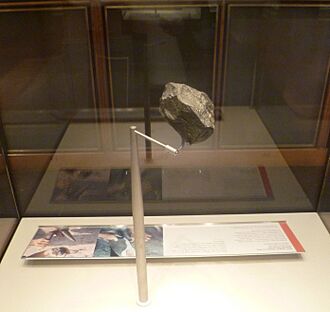
Ancient Times: Early Humans and Migrations
Tanzania is one of the oldest places where humans have lived continuously. Important ancient tools found in the Olduvai Gorge show how early human technology developed.
Over thousands of years, different groups of people moved into Tanzania. These included early hunter-gatherers, people who spoke Cushitic languages from the north, and later, people who spoke Nilotic languages. Around the same time, Bantu-speaking people from West Africa settled near Lake Victoria and Lake Tanganyika, bringing with them farming skills and iron-making.
The people of Tanzania were skilled in working with iron. For example, the Haya people developed special furnaces to make carbon steel over 1,500 years ago!
Medieval Period: Trade and Swahili City-States
From the early 1000s AD, Bantu-speaking communities built farming and trading villages along the Tanzanian coast. These grew into important Swahili city-states. They traded with people from the Persian Gulf and India across the Indian Ocean. Kilwa became a very powerful city-state, controlling trade routes, especially for gold.
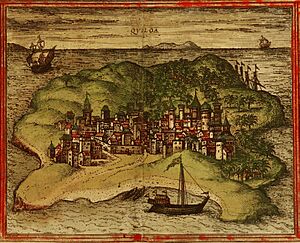
Colonial Era: German and British Rule
In the 1800s, the Sultan of Oman moved his capital to Zanzibar City, making Zanzibar a major trading hub. Slavery was a sad part of this history, but it was abolished in the 1890s.
Later, in 1885, Germany took control of the mainland area, calling it German East Africa. There was a big uprising against German rule called the Maji Maji Rebellion between 1905 and 1907. Many people suffered during this time due to fighting and famine.
After World War I, Britain took over the mainland, renaming it Tanganyika. Zanzibar remained a separate British area. During World War II, many Tanzanians joined the Allied forces and helped with food supplies.
Modern Tanzania: Independence and Unity
British rule ended on 9 December 1961, when Tanganyika gained its independence. Julius Nyerere became its first leader. Zanzibar became independent in 1963. In 1964, Tanganyika and Zanzibar decided to unite, forming the United Republic of Tanzania. This was a big step to bring different groups together and build a strong national identity.
President Nyerere introduced policies focused on socialism and African unity. Banks and many large industries became government-owned. Tanzania also worked with China to build the long TAZARA Railway connecting Dar es Salaam to Zambia.
In 1978, neighboring Uganda invaded Tanzania. Tanzania, with the help of Ugandan rebels, fought back and removed Uganda's leader at the time. This war, however, was very costly for Tanzania.
Tanzania won its first Olympic medals in 1980, earning two silver medals in running events. Over the years, famous national parks like Serengeti National Park and Kilimanjaro National Park were recognized as UNESCO World Heritage Sites.
In 1992, Tanzania changed its constitution to allow more political parties. Since then, the Chama Cha Mapinduzi (CCM) party has remained in power. In March 2021, President John Magufuli passed away, and his vice president, Samia Suluhu Hassan, became Tanzania's first female president. She was reelected for another term in the 2025 elections, with protests occurring following the election results.
Geography of Tanzania
Tanzania covers about 947,403 square kilometers (365,756 sq mi). It is the 13th largest country in Africa. It borders Kenya and Uganda to the north, Rwanda, Burundi, and the Democratic Republic of the Congo to the west, and Zambia, Malawi, and Mozambique to the south. Tanzania is on the eastern coast of Africa. It has a long coastline along the Indian Ocean. It also includes islands like Unguja (Zanzibar), Pemba, and Mafia.
Tanzania has both the highest and lowest points in Africa. Mount Kilimanjaro is the highest, at 5,895 meters (19,341 ft) above sea level. The floor of Lake Tanganyika is the lowest, at 1,471 meters (4,826 ft) below sea level.

The northeast of Tanzania is mountainous and forested, home to Mount Kilimanjaro. Three of Africa's Great Lakes are partly in Tanzania. These are Lake Victoria (Africa's largest lake) and Lake Tanganyika (the continent's deepest lake). Lake Nyasa is to the southwest. Central Tanzania is a large flat area with plains. The eastern coast is hot and humid, with the Zanzibar Archipelago just offshore.
Kalambo Falls is the second-highest uninterrupted waterfall in Africa. It is located near Lake Tanganyika, on the border with Zambia. The Menai Bay Conservation Area is Zanzibar's largest protected marine area.
Climate
Tanzania's climate varies a lot. In the highlands, temperatures are cooler, from 10 to 20 degrees Celsius (50-68°F). In most other parts of the country, temperatures rarely drop below 20 degrees Celsius (68°F). The hottest time is from November to February, with temperatures between 25-31 degrees Celsius (77-88°F). The coolest time is from May to August, with temperatures between 15-20 degrees Celsius (59-68°F).
Tanzania has two main rainy seasons. One is from October to April in the south, central, and western parts. The other is from October to December and March to May in the north and along the coast.
Climate change in Tanzania is causing temperatures to rise. This leads to more intense rainfall (causing floods) and dry periods (causing droughts). These changes affect farming, water, health, and energy. Rising sea levels are also expected to impact fishing.
Tanzania has plans to deal with climate change. It created a National Climate Change Strategy in 2012.
Wildlife and Nature
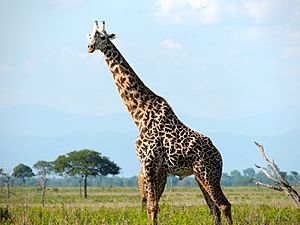
Tanzania is home to about 20% of Africa's large mammal population. These animals live in 21 National Parks, reserves, and marine parks. These protected areas cover about 38% of the country. Tanzania has many different animal habitats.
On Tanzania's Serengeti plain, large groups of wildebeest, other bovids, and zebra migrate every year. Tanzania has about 130 types of amphibians and over 275 types of reptiles. Many of these are found only in Tanzania. Tanzania also has the largest population of lions in the world.
In western Tanzania, Gombe Stream National Park is famous for Jane Goodall's long-term study of chimpanzee behavior, which began in 1960.
Government and Politics
How Tanzania is Governed
Tanzania is a country where one political party, the Chama Cha Mapinduzi (CCM), has been in power for a very long time. It has ruled since independence in 1961. Until 1992, it was the only legal party.
John Magufuli won the presidential election in October 2015. The main opposition party is called Chama cha Demokrasia na Maendeleo (Chadema). Its leader is Freeman Mbowe.
In Zanzibar, which is a semi-independent state within Tanzania, the main opposition party is The Alliance for Change and Transparency-Wazalendo (ACT-Wazalendo).
In March 2021, President John Magufuli passed away. His vice president, Samia Suluhu Hassan, became the country's president.
Leaders of the Country
The president of Tanzania and members of the National Assembly are chosen by public vote for five-year terms. The vice-president is elected at the same time as the president. The president chooses a prime minister from the National Assembly members. The prime minister leads the government in the assembly. The president also chooses her cabinet (group of top advisors).
Lawmaking Body
All laws for mainland Tanzania are made by the National Assembly. It has 393 members. These include elected members, the attorney general, and members chosen by the Zanzibar house of representatives. There are also special seats for women, making up at least 30% of a party's seats.
Court System
Tanzania's legal system is based on English common law.
Tanzania has a four-level court system. The lowest courts are Primary Courts. Appeals can go to District Courts or Resident Magistrates Courts. The highest court for appeals is the Court of Appeal of Tanzania.
Judges for the higher courts are chosen by the president of Tanzania.
Law Enforcement
The Tanzania Police Force is in charge of public safety and border control.
Zanzibar's Government
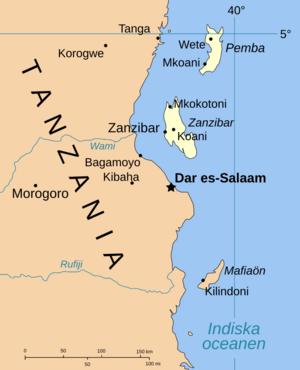
Zanzibar has its own government for matters that are not related to the union with mainland Tanzania. This is called the House of Representatives or Legislative Council.
The president of Zanzibar is the head of government there. Zanzibar has two vice-presidents. The president and members of the House of Representatives serve five-year terms.
Regions and Districts
Tanzania is divided into 31 regions. Twenty-six are on the mainland, and five are in Zanzibar. These regions are further divided into 195 districts. Some districts are urban (cities or towns), and others are rural.
The city of Dar es Salaam is special. It has a city council that works with three municipal councils. The city of Mwanza also has a city council that works with two municipal councils.
International Relations
Tanzania's foreign policy focuses on independence, human rights, and African unity. Its current policy, from 2001, also focuses on economic diplomacy and development. This means building relationships with other countries to help Tanzania's economy grow.
Tanzania is a member of many international groups. These include the UN, AU, EAC, and SADC. Because Tanzania has been peaceful, it often helps mediate agreements between other nations.
The United Nations has a strong presence in Tanzania. Many UN offices and related groups are based in Arusha. For example, the International Criminal Tribunal for Rwanda was located there.
Tanzania is a founding member of the African Union. The African Court of Justice and Human Rights is located in Arusha. Tanzania also joined the African Continental Free Trade Area in 2022. This is the largest free trade area in the world.
The East African Community (EAC) includes Tanzania, Uganda, Kenya, Rwanda, Burundi, South Sudan, and the Democratic Republic of Congo. Its headquarters are in Arusha. The EAC aims for economic and political cooperation. It has a customs union and a common market. There are plans for a single currency by 2024. The ultimate goal is a political federation of all member states.
Tanzania is also a founding member of the Southern African Development Community (SADC). SADC works for peace, security, and economic integration in Southern Africa.
Military
The Tanzania People's Defence Force (TPDF) is Tanzania's military. It has five branches: Land Force (army), Air Force, Naval Command, National Service, and Headquarter. Tanzanian citizens can volunteer for military service from age 15. Compulsory national service starts at 18 for those who finish advanced secondary school.
Tanzania is considered one of the most peaceful countries in the world.
Human Rights
In Tanzania, certain relationships are not allowed by law. People with albinism (a condition where skin, hair, and eyes lack pigment) have faced violence. This is due to harmful beliefs that their body parts have magical powers. Tanzania has banned witch doctors to try to stop this.
In 2019, Amnesty International reported that the Tanzanian government stopped allowing non-governmental organizations (NGOs) and individuals to directly file cases against it at the African Court for Human and Peoples' Rights.
Economy and Development
In 2021, Tanzania's economy was estimated to be worth about $71 billion. Its economy has grown well in recent years. This is thanks to strong tourism, telecommunications, and banking sectors.
Tanzania's main trading partners for exports in 2017 were India, Vietnam, South Africa, Switzerland, and China. Its main import partners were India, Switzerland, Saudi Arabia, China, and the United Arab Emirates.
In 2020, the World Bank announced that Tanzania's economy had moved from low income to lower middle income country. This was because its income per person increased. Tanzania's economy grew by 4.6 percent in 2022 and 5.2 percent in 2023.
Hunger and Poverty
Poverty is still a challenge in Tanzania. About 68% of Tanzanians live on less than $1.25 a day. About 32% of the population is malnourished. Challenges include using natural resources in ways that are not sustainable, climate change, and limited access to farming support.
The World Bank reported that poverty has decreased in the last 10 years. It fell from 34.4% in 2007 to 25.7% in 2020.
Farming
Tanzania's economy relies heavily on farming. In 2013, farming made up 24.5% of the country's total economic output. It also provided 85% of exports and employed half of the workforce. However, climate change has affected farming.
Common food crops include maize, cassava, sweet potatoes, and rice. Important cash crops (grown for sale) are sugar, cotton, cashew nuts, and coffee.
Industry and Energy
Industry and construction are growing parts of Tanzania's economy. This includes mining, manufacturing, and energy. Mining contributed 3.3% of the economy in 2013. Most of Tanzania's mineral export money comes from gold. Tanzania also exports diamonds and tanzanite (a unique gemstone).
Only a small percentage of Tanzanians had access to electricity in 2011, but this rose to 35.2% in 2018. The government-owned Tanzania Electric Supply Company Limited provides most of the electricity. Power outages can happen, especially during droughts.
Tanzania has found large amounts of natural gas since 2010. This gas is used to generate electricity. A gas pipeline from Mnazi Bay to Dar es Salaam was completed in 2015. This was expected to greatly increase the country's electricity production.
Tourism
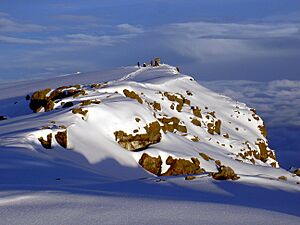
Travel and tourism are very important to Tanzania's economy. In 2016, it made up 17.5% of the country's economic output. It also provided 11% of jobs. The number of tourists visiting Tanzania has grown a lot.
Most tourists visit Zanzibar or the "northern circuit." This circuit includes Serengeti National Park, the Ngorongoro Conservation Area, Tarangire National Park, Lake Manyara National Park, and Mount Kilimanjaro. Serengeti was the most visited national park in 2013.
Banking
The Bank of Tanzania is the country's central bank. It is responsible for keeping prices stable and issuing the Tanzanian shilling currency.
Transportation
Most transportation in Tanzania happens by road. Roads carry over 75% of the country's goods and 80% of its passengers. The Cairo-Cape Town Highway passes through Tanzania.
Tanzania has two railway companies: TAZARA and Tanzania Railways Limited. Rail travel can be slow and have delays.
In Dar es Salaam, there is a large rapid bus project called Dar Rapid Transit (DART). It connects different parts of the city. The first phase was completed in 2015 and started operations in 2016.
Tanzania has four international airports and many smaller ones. Airlines include Air Tanzania, Precision Air, and Fastjet.
Communications
In 2013, the communications sector was the fastest-growing part of Tanzania's economy.
More and more Tanzanians are using mobile phones and the internet. The country has a fiber-optic cable network.
Food and Health
Poor nutrition is a problem in Tanzania, and it varies greatly by region. For example, in 2010, 34% of children experienced stunted growth due to malnutrition. Some regions have more issues with stunting than others. The Tanzania Food and Nutrition Centre says this is due to differences in mothers' nutrition, poor infant feeding, hygiene, and healthcare.
Droughts can greatly affect crop production. This leads to higher food prices. For example, the price of maize more than tripled from 2015 to 2017.
About 80% of Tanzanians are involved in subsistence farming (growing food for themselves). Rural areas often have more food shortages than cities.
Programs to Fight Hunger
Many programs aim to improve nutrition in Tanzania. USAID has "Feed the Future" programs. These invest in nutrition, infrastructure, and agriculture.
A Tanzanian government program called "Kilimo Kwanza" (Agriculture First) encourages investment in farming. It hopes to improve farming methods.
Organizations like the World Food Programme (WFP) also work in Tanzania. The WFP provides fortified food to pregnant women and mothers. They also supply food to refugees.
UNICEF and Irish Aid helped create the Partnership for Nutrition in Tanzania (PANITA). PANITA works with local groups to improve nutrition. It also ensures that nutrition is a focus in national and regional development plans.
Science and Technology
Tanzania adopted its first "National Science and Technology Policy" in 1996. The government's "Vision 2025" aims to make the economy strong using science and technology.
In 2010, Tanzania spent 0.38% of its economic output on research and development. This is lower than the global average. Tanzania was ranked 120th in the Global Innovation Index in 2024.
People of Tanzania
| Year | Million |
|---|---|
| 1950 | 7.9 |
| 2000 | 35.1 |
| 2018 | 56.3 |
| 2024 | 67.5 |
In 2024, Tanzania's population was about 67.5 million. About 44.1% of the population is under 15 years old.
Most people live along the northern border or the coast. Other parts of the country are less populated. About 70% of the population lives in rural areas. Dar es Salaam is the largest city. Dodoma is the capital city.
The child mortality rate (deaths of children under five) has greatly decreased since 1964.
|
Largest cities or towns in Tanzania
2012 Census General Report, March 2013 Combined Final for Printing |
||
|---|---|---|
| Rank | Name | Pop. |
| 1 | Dar es Salaam | 4,364,541 |
| 2 | Mwanza | 706,543 |
| 3 | Arusha | 416,442 |
| 4 | Dodoma | 410,956 |
| 5 | Mbeya | 385,279 |
| 6 | Morogoro | 315,866 |
| 7 | Tanga | 273,332 |
| 8 | Kahama | 242,208 |
| 9 | Tabora | 226,999 |
| 10 | Zanzibar City | 223,033 |
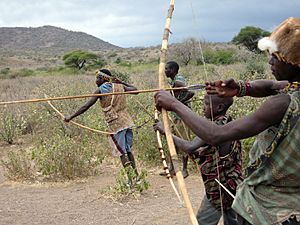
Tanzania has about 125 ethnic groups. The Sukuma, Nyamwezi, Chagga, and Haya are some of the largest groups. Most Tanzanians are of native African descent. There are also significant communities of people of Indian and Chinese descent. Many Tanzanians identify as Shirazis. Some are of Arab descent.
Religions
| Religion in Tanzania (2020) | ||||
|---|---|---|---|---|
| Christianity | 63.1% | |||
| Islam | 34.1% | |||
| Folk relgion | 1.1% | |||
| Other | 1.6% | |||
| Source: CIA World Factbook. | ||||
Official statistics on religion are not available since 1967. Tanzania's main religions are Christianity, Islam, and traditional African beliefs. Sometimes, people follow more than one religion.
In 2020, about 63.1% of the population was Christian, and 34.1% was Muslim. Most people in Zanzibar are Muslim. Most Tanzanian Muslims are Sunni.
The Catholic Church is the largest Christian group. Other large Protestant groups include Lutherans and Anglicans. There are also growing numbers of Pentecostals and Adventists.
There are smaller communities of Buddhists, Hindus, and Baháʼís.
Languages
More than 100 languages are spoken in Tanzania. This makes it the most diverse country in East Africa for languages. Tanzania does not have an official language by law.
Swahili is used in parliament, in lower courts, and for teaching in primary schools. English is used for international trade, diplomacy, and in higher education. The government plans to stop using English as the main teaching language.
President Nyerere encouraged the use of Swahili to help unite the country's many ethnic groups. About 10% of Tanzanians speak Swahili as their first language. Up to 90% speak it as a second language. Many educated Tanzanians speak three languages, including English. The widespread use of Swahili is causing smaller languages to decline.
Education and Libraries
In 2015, the literacy rate (people who can read and write) in Tanzania was 77.9% for those aged 15 and over. Education is required until age 15. In 2020, 97% of children finished primary school.
The Tanzania Library Services Board runs many libraries across the country.
Healthcare
In 2012, the average life expectancy was 61 years. The number of children under five who passed away was 54 per 1,000 live births.
Malaria is a major health problem in Tanzania. It causes many illnesses and deaths.
On January 21, 2025, Tanzania's President, Samia Suluhu Hassan, confirmed an outbreak of the Marburg virus. This is a very infectious disease similar to Ebola. The government is working to control the virus and is cooperating with international health groups.
Women in Tanzania
Women and men have equal rights under the law. The government signed an agreement to end all forms of discrimination against women in 1985.
The Constitution of Tanzania requires that women make up at least 30% of all elected members of the National Assembly.
Culture
Music
Music in Tanzania is always changing and varies by place and occasion. The main music styles are ngoma, dansi, kwaya, and taarab. Bongo flava was added in 2001. Singeli is a newer popular style since the mid-2000s.
- Ngoma is traditional dance music.
- Dansi is urban jazz or band music.
- Taarab is sung Swahili poetry with a band.
- Kwaya is choir music, now used in many events.
- Bongo flava is Tanzanian pop music. It started in the early 2000s. It mixes reggae, R&B, hip hop, taarab, and dansi.
- Singeli is a fast-paced ngoma music style.
Before 1993, the government controlled all music recording and broadcasting. Only the four traditional genres were allowed. After 1993, private radio stations and studios opened. This helped Bongo flava spread across the country.
National Anthem
Tanzania's national anthem is "Mungu Ibariki Africa" (God Bless Africa). Its Swahili words are based on "Nkosi Sikelel' iAfrika", a song composed in South Africa in 1897. This song became a pan-African anthem.
Literature
Tanzania has a strong oral storytelling tradition. This includes folktales, poems, riddles, proverbs, and songs. Most recorded oral literature is in Swahili. However, each language in Tanzania has its own oral traditions.
Books in Tanzania can be expensive and hard to find. Most written literature is in Swahili or English. Important writers include Shaaban Robert (known as the father of Swahili literature) and Abdulrazak Gurnah.
Painting and Sculpture
Two Tanzanian art styles are known internationally. The Tingatinga school of painting was started by Edward Said Tingatinga. These are bright, colorful enamel paintings on canvas. They often show people, animals, or daily life. After Tingatinga passed away in 1972, other artists continued and developed his style. It is now a very popular art style for tourists in East Africa.
Sports
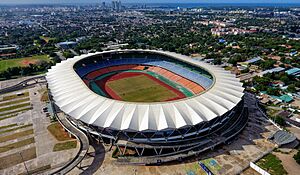
Football is very popular in Tanzania. The most popular professional football clubs in Dar es Salaam are the Young Africans F.C. and Simba S.C.. The Tanzania Football Federation manages football in the country.
Other popular sports include basketball, netball, boxing, volleyball, athletics, and rugby.
Cinema
Tanzania has a popular film industry called "Bongo Movie." It also hosts an international film festival, the Zanzibar International Film Festival.
See also
 In Spanish: Tanzania para niños
In Spanish: Tanzania para niños




